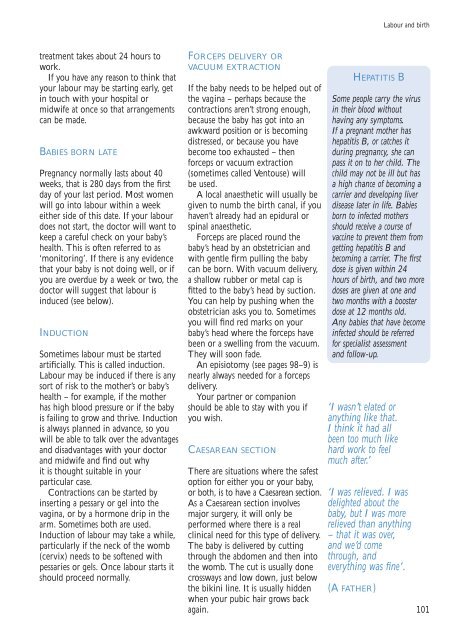here - Health Promotion Agency
here - Health Promotion Agency
here - Health Promotion Agency
Create successful ePaper yourself
Turn your PDF publications into a flip-book with our unique Google optimized e-Paper software.
Labour and birth<br />
treatment takes about 24 hours to<br />
work.<br />
If you have any reason to think that<br />
your labour may be starting early, get<br />
in touch with your hospital or<br />
midwife at once so that arrangements<br />
can be made.<br />
BABIES BORN LATE<br />
Pregnancy normally lasts about 40<br />
weeks, that is 280 days from the first<br />
day of your last period. Most women<br />
will go into labour within a week<br />
either side of this date. If your labour<br />
does not start, the doctor will want to<br />
keep a careful check on your baby’s<br />
health. This is often referred to as<br />
‘monitoring’. If t<strong>here</strong> is any evidence<br />
that your baby is not doing well, or if<br />
you are overdue by a week or two, the<br />
doctor will suggest that labour is<br />
induced (see below).<br />
INDUCTION<br />
Sometimes labour must be started<br />
artificially. This is called induction.<br />
Labour may be induced if t<strong>here</strong> is any<br />
sort of risk to the mother’s or baby’s<br />
health – for example, if the mother<br />
has high blood pressure or if the baby<br />
is failing to grow and thrive. Induction<br />
is always planned in advance, so you<br />
will be able to talk over the advantages<br />
and disadvantages with your doctor<br />
and midwife and find out why<br />
it is thought suitable in your<br />
particular case.<br />
Contractions can be started by<br />
inserting a pessary or gel into the<br />
vagina, or by a hormone drip in the<br />
arm. Sometimes both are used.<br />
Induction of labour may take a while,<br />
particularly if the neck of the womb<br />
(cervix) needs to be softened with<br />
pessaries or gels. Once labour starts it<br />
should proceed normally.<br />
FORCEPS DELIVERY OR<br />
VACUUM EXTRACTION<br />
If the baby needs to be helped out of<br />
the vagina – perhaps because the<br />
contractions aren’t strong enough,<br />
because the baby has got into an<br />
awkward position or is becoming<br />
distressed, or because you have<br />
become too exhausted – then<br />
forceps or vacuum extraction<br />
(sometimes called Ventouse) will<br />
be used.<br />
A local anaesthetic will usually be<br />
given to numb the birth canal, if you<br />
haven’t already had an epidural or<br />
spinal anaesthetic.<br />
Forceps are placed round the<br />
baby’s head by an obstetrician and<br />
with gentle firm pulling the baby<br />
can be born. With vacuum delivery,<br />
a shallow rubber or metal cap is<br />
fitted to the baby’s head by suction.<br />
You can help by pushing when the<br />
obstetrician asks you to. Sometimes<br />
you will find red marks on your<br />
baby’s head w<strong>here</strong> the forceps have<br />
been or a swelling from the vacuum.<br />
They will soon fade.<br />
An episiotomy (see pages 98–9) is<br />
nearly always needed for a forceps<br />
delivery.<br />
Your partner or companion<br />
should be able to stay with you if<br />
you wish.<br />
CAESAREAN SECTION<br />
T<strong>here</strong> are situations w<strong>here</strong> the safest<br />
option for either you or your baby,<br />
or both, is to have a Caesarean section.<br />
As a Caesarean section involves<br />
major surgery, it will only be<br />
performed w<strong>here</strong> t<strong>here</strong> is a real<br />
clinical need for this type of delivery.<br />
The baby is delivered by cutting<br />
through the abdomen and then into<br />
the womb. The cut is usually done<br />
crossways and low down, just below<br />
the bikini line. It is usually hidden<br />
when your pubic hair grows back<br />
again.<br />
HEPATITIS B<br />
Some people carry the virus<br />
in their blood without<br />
having any symptoms.<br />
If a pregnant mother has<br />
hepatitis B, or catches it<br />
during pregnancy, she can<br />
pass it on to her child. The<br />
child may not be ill but has<br />
a high chance of becoming a<br />
carrier and developing liver<br />
disease later in life. Babies<br />
born to infected mothers<br />
should receive a course of<br />
vaccine to prevent them from<br />
getting hepatitis B and<br />
becoming a carrier. The first<br />
dose is given within 24<br />
hours of birth, and two more<br />
doses are given at one and<br />
two months with a booster<br />
dose at 12 months old.<br />
Any babies that have become<br />
infected should be referred<br />
for specialist assessment<br />
and follow-up.<br />
‘I wasn’t elated or<br />
anything like that.<br />
I think it had all<br />
been too much like<br />
hard work to feel<br />
much after.’<br />
‘I was relieved. I was<br />
delighted about the<br />
baby, but I was more<br />
relieved than anything<br />
– that it was over,<br />
and we’d come<br />
through, and<br />
everything was fine’.<br />
(A FATHER)<br />
101
















